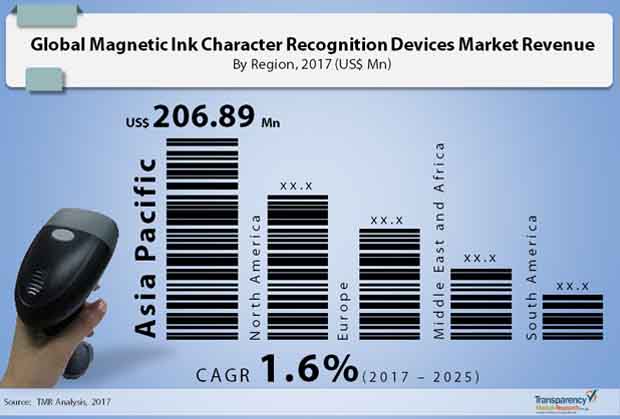Magnetic Ink Character Recognition (Micr) Devices Market: Swift Uptake By Banking Sector Stokes Growth
Some of the prominent participants in global magnetic ink character recognition (MICR) devices market are ACOM Solutions, Inc., Canon, Inc., Hewlett Packard Company, Epson America, Inc., Murni Solusindo Nusantara, MagTek, Inc., Panini SpA, Rosetta Technologies, Inc., Vertical Infonet Pvt.Ltd., Source Technologies, Troy Group, Inc., Xerox Corporation Ltd, Uniform Industrial Corporation, and ZIH Corp.
A recently published research study by Transparency Market Research predicts the global market for magnetic ink character recognition devices to grow at tepid pace in the years to come. As per the report, the market is expected to clock a 1.6% CAGR during the period from 2017 to 2025 to become worth US$665.6 mn by 2025.
MICR printing and recognition technology are the two main types of technologies employed in the global magnetic ink character recognition (MICR) devices market. The recognition technology accounted for over 60.0% share in the market in 2016 because of the growing demand for secure and efficient check and financial document processing across the industries.
Geographically, the key segments of the global market for magnetic ink character recognition devices are North America, South America, Europe, Asia Pacific, and the Middle East and Africa. Of them, Asia Pacific led the market in 2016 with maximum share. The ability of MICR to increase speed of check processing and also authenticate the validity of financial documents has created demand for them in the financial sector particularly. By registering a CAGR of 2.3% in the forecast period, the market in Asia Pacific is expected to retain its leading share in the years ahead too.

Get PDF Sample for this Research Report @ https://www.transparencymarketresearch.com/sample/sample.php?flag=S&rep_id=3154
Need for Fast and Secure Document Management Technology Boosts Demand
Magnetic ink character recognition (MICR) is a technology used to validate the originality or legitimacy of paper documents, specifically checks. Their demand is primarily fuelled by the need for fast and secure document management technology across nations worldwide. Besides, end-users such as government, retail, transportation and banking, financial services and insurance (BFSI) are also contributing to their demand. They rely on MICR technology for high-performance, high-quality and cost-effective financial document and check printing. For example, the pressing need for further optimizing the check processing speed is expected to offer growth avenues to the market for magnetic ink character recognition devices.